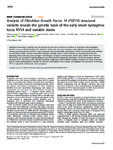Analysis of Fibroblast Growth Factor 14 (FGF14) structural variants reveals the genetic basis of the early onset nystagmus locus NYS4 and variable ataxia
| dc.contributor.author | Ceroni, F | |
| dc.contributor.author | Osborne, D | |
| dc.contributor.author | Clokie, S | |
| dc.contributor.author | Bax, DA | |
| dc.contributor.author | Cassidy, EJ | |
| dc.contributor.author | Dunn, MJ | |
| dc.contributor.author | Harris, CM | |
| dc.contributor.author | Self, JE | |
| dc.contributor.author | Ragge, NK | |
| dc.date.accessioned | 2022-10-07T12:25:23Z | |
| dc.date.available | 2022-10-07T12:25:23Z | |
| dc.date.issued | 2023-03 | |
| dc.identifier.issn | 1018-4813 | |
| dc.identifier.issn | 1476-5438 | |
| dc.identifier.uri | http://hdl.handle.net/10026.1/19678 | |
| dc.description.abstract |
<jats:title>Abstract</jats:title><jats:p>Nystagmus (involuntary, rhythmical eye movements) can arise due to sensory eye defects, in association with neurological disorders or as an isolated condition. We identified a family with early onset nystagmus and additional neurological features carrying a partial duplication of <jats:italic>FGF14</jats:italic>, a gene associated with spinocerebellar ataxia type 27 (SCA27) and episodic ataxia. Detailed eye movement analysis revealed oculomotor anomalies strikingly similar to those reported in a previously described four-generation family with early onset nystagmus and linkage to a region on chromosome 13q31.3-q33.1 (NYS4). Since <jats:italic>FGF14</jats:italic> lies within NYS4, we revisited the original pedigree using whole genome sequencing, identifying a 161 kb heterozygous deletion disrupting <jats:italic>FGF14</jats:italic> and <jats:italic>ITGBL1</jats:italic> in the affected individuals, suggesting an <jats:italic>FGF14</jats:italic>-related condition. Therefore, our study reveals the genetic variant underlying NYS4, expands the spectrum of pathogenic <jats:italic>FGF14</jats:italic> variants, and highlights the importance of screening <jats:italic>FGF14</jats:italic> in apparently isolated early onset nystagmus.</jats:p> | |
| dc.format.extent | 353-359 | |
| dc.format.medium | Print-Electronic | |
| dc.language | en | |
| dc.language.iso | en | |
| dc.publisher | Springer Science and Business Media LLC | |
| dc.subject | Humans | |
| dc.subject | Ataxia | |
| dc.subject | Fibroblast Growth Factors | |
| dc.subject | Integrin beta1 | |
| dc.subject | Nystagmus, Pathologic | |
| dc.subject | Pedigree | |
| dc.subject | Spinocerebellar Degenerations | |
| dc.title | Analysis of Fibroblast Growth Factor 14 (FGF14) structural variants reveals the genetic basis of the early onset nystagmus locus NYS4 and variable ataxia | |
| dc.type | journal-article | |
| dc.type | Article | |
| plymouth.author-url | https://www.ncbi.nlm.nih.gov/pubmed/36207621 | |
| plymouth.issue | 3 | |
| plymouth.volume | 31 | |
| plymouth.publisher-url | http://dx.doi.org/10.1038/s41431-022-01197-5 | |
| plymouth.publication-status | Published | |
| plymouth.journal | European Journal of Human Genetics | |
| dc.identifier.doi | 10.1038/s41431-022-01197-5 | |
| plymouth.organisational-group | /Plymouth | |
| plymouth.organisational-group | /Plymouth/Faculty of Health | |
| plymouth.organisational-group | /Plymouth/Research Groups | |
| plymouth.organisational-group | /Plymouth/Research Groups/Centre for Brain, Cognition and Behaviour (CBCB) | |
| plymouth.organisational-group | /Plymouth/Research Groups/Centre for Brain, Cognition and Behaviour (CBCB)/Brain | |
| plymouth.organisational-group | /Plymouth/Users by role | |
| dc.publisher.place | England | |
| dcterms.dateAccepted | 2022-09-14 | |
| dc.identifier.eissn | 1476-5438 | |
| dc.rights.embargoperiod | Not known | |
| rioxxterms.versionofrecord | 10.1038/s41431-022-01197-5 | |
| rioxxterms.licenseref.uri | http://www.rioxx.net/licenses/all-rights-reserved | |
| rioxxterms.type | Journal Article/Review |


